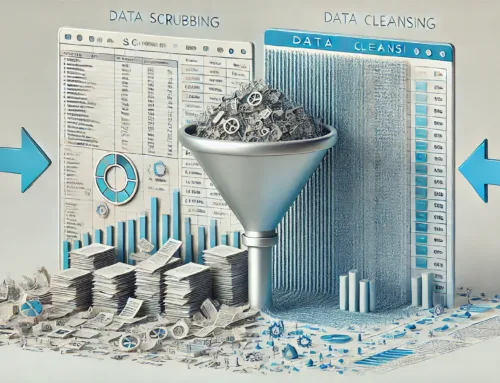The road ahead is lined with challenges in data scrubbing that demand your attention. From unraveling the complexity of data to navigating the maze of privacy regulations, each hurdle poses a unique test to your data cleansing endeavors. But fear not, for within these challenges lie opportunities to enhance your data management strategies and fortify your decision-making processes. By addressing these obstacles head-on, you can pave the way for smoother operations and more reliable insights. Stay tuned to discover how these challenges can be transformed into stepping stones towards data excellence.
Data Complexity
When dealing with data complexity, you may encounter a myriad of challenges that require careful navigation. Two key aspects that demand particular attention are data quality and data validation. Ensuring data quality involves verifying that the information in your database is accurate, consistent, and relevant to your needs. This process often involves identifying and correcting errors, duplicates, and inconsistencies within the dataset. Data validation, on the other hand, focuses on confirming that the data adheres to predefined standards and rules, ensuring its reliability and usability for analysis.
Data quality is crucial as it directly impacts the effectiveness of any data-driven decision-making process. Poor data quality can lead to faulty conclusions and misguided strategies. Data validation, on the other hand, acts as a gatekeeper, preventing incorrect or incomplete data from entering your system and compromising the integrity of your analyses. Both aspects require meticulous attention to detail and thorough analysis to overcome the complexities associated with managing and scrubbing large datasets effectively.
Data Volume
When dealing with data volume in your data scrubbing process, scalability issues can arise as the amount of data increases. Managing the resources required to handle large volumes of data becomes crucial to ensure efficient and effective scrubbing. Allocating the necessary resources strategically will help in maintaining the performance and accuracy of the data scrubbing process.
Scalability Issues
Addressing the scalability issues related to data volume is crucial in the context of data scrubbing. When dealing with large volumes of data, several challenges may arise:
- Data Integrity: Ensuring that the data remains accurate and consistent throughout the scrubbing process is essential for maintaining the overall quality of the dataset.
- Resource Constraints: Limited resources such as processing power and memory can hinder the ability to efficiently scrub large datasets, impacting the speed and effectiveness of the cleansing process.
- Scalability Solutions: Implementing scalable data scrubbing tools and techniques, such as parallel processing or distributed computing, can help manage the increased workload and ensure the quality of the data is maintained even with growing volumes.
In managing scalability issues, the focus should be on balancing data quality and accuracy while optimizing resources to handle large datasets effectively. By addressing these challenges proactively, you can enhance the efficiency and effectiveness of your data scrubbing process.
Resource Allocation
To effectively manage resource allocation in the context of data volume, it is imperative to consider the impact on data scrubbing efficiency. When dealing with large volumes of data, allocating the right resources becomes crucial for ensuring data validation and accuracy. The quality of data cleansing directly correlates with the resources allocated to handle the volume effectively.
Inadequate resource allocation can lead to data quality issues, affecting the overall success of the data scrubbing process. Insufficient resources may result in incomplete data validation, compromising the accuracy of the cleaned data. By allocating appropriate resources, such as sufficient processing power and storage capacity, you can enhance data quality and streamline the data cleansing process.
Effective resource allocation is pivotal in managing data volume during the scrubbing process. It ensures that the necessary tools and infrastructure are in place to carry out comprehensive data validation and maintain high levels of data accuracy. Prioritizing resource allocation for data scrubbing can significantly impact the overall quality and success of the data cleansing efforts.
Data Privacy
When it comes to data privacy, it’s essential to navigate the complex landscape of privacy regulations that govern how data is handled and protected. Anonymization techniques play a crucial role in safeguarding sensitive information by removing personally identifiable details while maintaining the integrity of the data for analysis. Understanding and implementing these techniques are vital for ensuring compliance with regulations and maintaining the trust of individuals whose data is being processed.
Privacy Regulations
Navigating the landscape of data scrubbing involves confronting the intricate web of privacy regulations, particularly those surrounding data privacy. When it comes to privacy regulations in data scrubbing, here are some key points to consider:
- Compliance Challenges: Ensuring that your data scrubbing processes comply with various privacy regulations such as GDPR, HIPAA, or CCPA can be complex and time-consuming.
- Legal Implications: Non-compliance with privacy regulations can lead to severe consequences, including hefty fines and damage to your organization’s reputation.
- Data Protection: Privacy regulations aim to safeguard sensitive information from unauthorized access, reducing the risk of data breaches and enhancing overall data security.
Understanding and adhering to privacy regulations is crucial in data scrubbing to maintain trust with customers, protect sensitive data, and avoid legal repercussions. By staying informed and implementing robust privacy practices, you can navigate the regulatory landscape effectively.
Anonymization Techniques
Effectively anonymizing data is a critical aspect of data scrubbing to protect individuals’ privacy and comply with regulations. Anonymization techniques such as data masking, pseudonymization, and de-identification play a crucial role in safeguarding sensitive information. Data masking involves replacing original data with fictional data while preserving the data format for testing or analysis purposes. Pseudonymization replaces identifiable information with pseudonyms, allowing data to be linked back to the original source through additional information kept separately. De-identification involves removing or modifying personal identifiers from a dataset to prevent re-identification of individuals.
These anonymization techniques are essential for maintaining data protection and confidentiality. By implementing robust anonymization methods, organizations can minimize the risk of data breaches and unauthorized access. Compliance with data privacy regulations like GDPR and HIPAA requires the adoption of effective anonymization practices. Properly anonymized data ensures that personal information remains secure while still allowing for valuable insights to be extracted for analysis and decision-making purposes.
Data Standardization
To achieve effective data scrubbing, one of the crucial steps is data standardization. Standardizing your data is essential for ensuring data accuracy and consistency throughout your databases. Here are three key points to consider:
- Normalization: Normalize your data by structuring it in a uniform format. This includes setting standards for date formats, units of measurement, and naming conventions to enhance data consistency.
- De-duplication: Identify and eliminate duplicate entries within your datasets. Removing duplicates not only improves data accuracy but also streamlines data analysis processes.
- Data Validation: Implement validation rules to check the quality and integrity of your data. This involves verifying that data entries meet specific criteria, enhancing data accuracy and reliability.
Data standardization lays the foundation for successful data scrubbing by ensuring that your data is clean, consistent, and reliable for further analysis and decision-making processes.
Data Maintenance
Maintaining your data is a critical aspect of ensuring its ongoing accuracy and relevance. Utilizing automation tools is key in efficiently managing this process. These tools can help streamline tasks such as data validation, cleansing, and enrichment, ultimately improving data quality. Automation tools can automatically detect and rectify inconsistencies, duplicates, and outdated information, reducing the chances of errors slipping through the cracks. By implementing automated data maintenance processes, you can proactively monitor the health of your data, ensuring that it remains reliable and up-to-date.
Data quality plays a significant role in data maintenance. Regularly assessing the quality of your data is essential for identifying areas that require attention. Automation tools can aid in this by providing insights into data integrity, consistency, and completeness. By leveraging these tools to maintain high data quality standards, you can enhance decision-making processes and maximize the value derived from your data assets. Remember, efficient data maintenance is crucial for sustaining the accuracy and relevance of your data over time.
Manual Errors
When managing data, one of the key challenges that organizations face is the occurrence of manual errors. Manual errors can significantly impact the overall data quality and integrity of a database. To address this issue effectively, it is crucial to focus on error detection and prevention strategies. Here are three key points to consider:
- Inconsistent Data Entry: Manual errors often stem from inconsistencies in data entry processes. Implementing standardized data entry protocols and providing adequate training to employees can help mitigate this issue.
- Lack of Data Validation: Failure to validate data entries can lead to inaccuracies and discrepancies in the database. Utilizing automated data validation tools and conducting regular audits can aid in identifying and rectifying errors promptly.
- Human Oversight: Human oversight is a common factor contributing to manual errors. Implementing cross-checking mechanisms and establishing clear data verification procedures can help minimize the occurrence of such errors and enhance data quality overall.
Resource Allocation
Manual errors in data management can often lead to a necessity for increased resource allocation in order to rectify discrepancies and ensure data accuracy. When faced with resource allocation challenges, it is crucial to consider various factors such as budget constraints, team collaboration, time management, and data quality.
Budget constraints play a significant role in determining the extent to which resources can be allocated for data scrubbing activities. It is essential to prioritize tasks based on their impact on data quality while staying within the allocated budget. Team collaboration is another key aspect as it ensures that resources are utilized efficiently and that tasks are completed in a timely manner. Effective communication and coordination among team members can help streamline the resource allocation process and optimize outcomes.
Moreover, proper time management is essential to allocate resources effectively and meet project deadlines. By identifying critical areas that require immediate attention, resources can be allocated efficiently to address data discrepancies promptly. Ultimately, resource allocation plays a vital role in enhancing data quality and ensuring accurate decision-making processes.
Frequently Asked Questions
How Can Data Scrubbing Help Improve Data Accuracy?
By using data scrubbing, you enhance data accuracy by improving data quality through error detection. It helps in identifying and rectifying inconsistencies, duplicates, and inaccuracies, ensuring your data is reliable and actionable.
What Are the Common Tools Used for Data Scrubbing?
When it comes to data scrubbing, common tools like Excel, OpenRefine, and Talend are often used. Best practices include identifying inconsistencies, removing duplicates, and ensuring data integrity. These tools streamline the process and enhance accuracy.
Is Data Scrubbing a One-Time Process or Continuous?
Data scrubbing is not a one-time task; it’s ongoing to maintain data quality. Regular scrubbing ensures accuracy and reliability. Automation benefits by streamlining the process, saving time, and reducing errors, making it vital for data integrity.
How Does Data Scrubbing Impact Data Analysis Results?
When you scrub data, you enhance data quality and integrity by removing errors and inconsistencies. This process positively impacts data analysis results by ensuring accurate and reliable information for making informed decisions and drawing meaningful insights.
What Are the Potential Risks of Inadequate Data Scrubbing?
When data scrubbing falls short, you risk compromising data integrity. Inadequate cleansing threatens data quality, leading to skewed insights and flawed decisions. Always prioritize thorough data scrubbing to safeguard the accuracy and reliability of your analyses.




